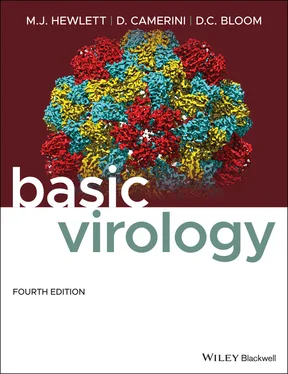It is a major problem in the study of biology at a detailed molecular and functional level that almost no generalization is sacred, and the concept of viruses as simple parasitic collections of genes functioning to replicate themselves at the expense of the cell they attack does not hold up. Many generalizations will be made in the survey of the world of viruses introduced in this book; most if not all will be ultimately classified as being useful, but unreliable, tools for the full understanding and organization of information.
Even the size range of viral genomes, generalized to range from one or two genes to a few hundred at most (significantly less than those contained in the simplest free‐living cells), cannot be supported by a close analysis of data. While it is true that the vast majority of viruses studied range in size from smaller than the smallest organelle to just smaller than the simplest cells capable of energy metabolism and protein synthesis, the mycoplasma and simple unicellular algae, the recently discovered mimivirus (distantly related to poxviruses such as smallpox or variola) contains nearly 1000 genes and is significantly larger than the smallest cells. With such caveats in mind, it is still appropriate to note that despite their limited size, viruses have evolved and appropriated a means of propagation and replication that ensures their survival in free‐living organisms that are generally between 10 and 10 000 000 times their size and genetic complexity.
The effect of virus infections on the host organism and populations – viral pathogenesis, virulence, and epidemiology
Since a major motivating factor for the study of virology is that viruses cause disease of varying levels of severity in human populations and in the populations of plants and animals that support such populations, it is not particularly surprising that virus infections have historically been considered episodic interruptions of the wellbeing of a normally healthy host. This view was supported in some of the earliest studies on bacterial viruses, which were seen to cause the destruction of the host cell and general disruption of healthy, growing populations of the host bacteria. Despite this, it was seen with another type of bacterial virus that a persistent, lysogenicinfection could ensue in the host population. In this case, stress to the lysogenic bacteria could release infectious virus long after the establishment of the initial infection.
These two modes of infection of host populations by viruses, which can be accurately modeled by mathematical methods developed for studying predator–prey relationships in animal and plant populations, are now understood to be general for virus–host interactions. Indeed, persistent infections with low or no levels of viral disease are universal in virus–host ecosystems that have evolved together for extended periods – it is only upon the introduction of a virus into a novel population that widespread disease and host morbidityoccur.
While we can therefore consider severe virus‐induced disease to be evidence of a recent introduction of the virus into the population in question, the accommodation of the one to the other is a very slow process requiring genetic changes in both virus and host, and it is by no means certain that the accommodation can occur without severe disruption of the host population – even its extinction. For this reason, the study of the replication and propagation of a given virus in a population is of critical importance to the body politic, especially in terms of formulating and implementing health policy. This is, of course, in addition to its importance to the scientific and medical communities.
The study of viral pathogenesisis broadly defined as the study of effects of viral infection on the host. The pathogenicity of a virus is defined as the sum total of the virus‐encoded functions that contribute to virus propagation in the infected cell, in the host organism, and in the population. Pathogenicity is essentially the genetic ability of members of a given specific virus population (which can be considered to be genetically more or less equivalent) to cause a disease and spread through ( propagatein) a population. Thus, a major factor in the pathogenicity of a given virus is its genetic makeup or genotype.
The basis for severity of the symptoms of a viral disease in an organism or a population is complex. It results from an intricate combination of expression of the viral genes controlling pathogenicity, physiological response of the infected individual to these pathogenic determinants, and response of the population to the presence of the virus propagating in it. Taken together, these factors determine or define the virulenceof the virus and the disease it causes.
A basic factor contributing to virulence is the interaction among specific viral genes and the genetically encoded defenses of the infected individual. It is important to understand, however, that virulence is also affected by the general health and genetic makeup of the infected population, and in humans, by the societal and economic factors that affect the nature and extent of the response to the infection.
The distinction and gradation of meanings between the terms pathogenesis and virulence can be understood by considering the manifold factors involved in disease severity and spread exhibited in a human population subjected to infection with a disease‐causing virus. Consider a virus whose genotype makes it highly efficient in causing a disease, the signs and symptoms of which are important in the spread between individuals – perhaps a respiratory infection with accompanying sneezing, coughing, and so on. This ideal or optimal virus will incorporate numerous, random genetic changes during its replication cycles as it spreads in an individual and in the population. Some viruses generated during the course of a disease may, then, contain genes that are not optimally efficient in causing symptoms. Such a virus is of reduced virulence, and in the extreme case, it might be a virus that has accumulated so many mutations in pathogenic genes that it can cause no disease at all (i.e., has mutated to an avirulentor apathogenicstrain). While an avirulent virus may not cause a disease, its infection may well lead to complete or partial immunityagainst the most virulent genotypes in an infected individual. This is the basis of vaccination, which is described in Part II, Chapter 8. But the capacity to generate an immune response and the resulting generation of herd immunityalso mean that as a virus infection proceeds in a population, either its virulence must change or the virus must genetically adapt to the changing host.
Other factors not fully correlated with the genetic makeup of a virus also contribute to variations in virulence of a pathogenic genotype. The same virus genotype infecting two immunologically naiveindividuals (i.e., individuals who have never been exposed to any form of the virus leading to an immune response) can cause very different outcomes. One individual might only have the mildest symptoms because of exposure to a small amount of virus, or infection via a suboptimal route, or a robust set of immune and other defense factors inherent in his or her genetic makeup. Another individual might have a very severe set of symptoms or even death if he or she receives a large inoculum, or has impaired immune defenses, or happens to be physically stressed due to malnutrition or other diseases.
Also, the same virus genotype might cause significantly different levels of disease within two more‐or‐less genetically equivalent populations that differ in economic and technological resources. This could happen because of differences in the ability of one society's support net to provide for effective medical treatment, or to provide for isolation of infected individuals, or to have available the most effective treatment protocols.
Читать дальше












